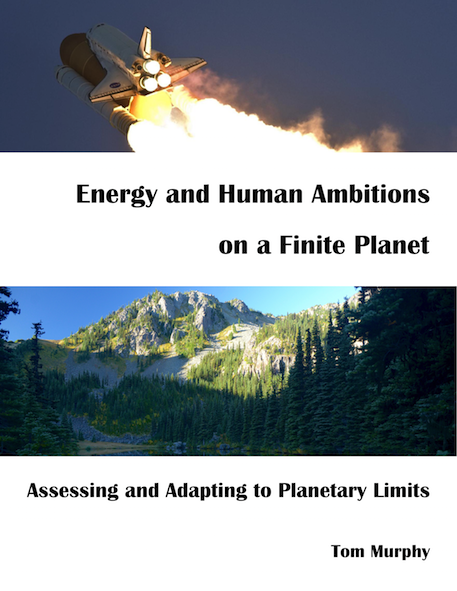 This book, Energy and Human Ambitions on a Finite Planet, by Tom Murphy (TM), grew out of a course at University of California (San Diego), so it should be regarded both as a textbook and as a book for a wide general readership. This reviewer has also taught similar material at the introductory level to undergraduates, so its suitability can be verified for the classroom – particularly with all the useful suggested questions that can be posed for students..
This book, Energy and Human Ambitions on a Finite Planet, by Tom Murphy (TM), grew out of a course at University of California (San Diego), so it should be regarded both as a textbook and as a book for a wide general readership. This reviewer has also taught similar material at the introductory level to undergraduates, so its suitability can be verified for the classroom – particularly with all the useful suggested questions that can be posed for students..
The message in this book is simple, stated clearly towards the end of the first chapter. There are hard physical limits to the growth of available energy to power our civilization and these will probably be seriously in effect by the end of the 21st century. TM judges we are undoubtedly closer to the end of growth than we were at its beginning in the 19th century.
This energy problem will bring economic growth to a virtual standstill because energy and growth so far have shown no sign of being decoupled. The central theme of this and many similar books is that any amount of constant growth is not possible on a planet of finite resources. This may be true throughout the galaxy, a point TM is well qualified to make.
To those wedded to the idea that in an overpopulated world it would be possible to offload a substantial number of people into space (Moon-Mars-anywhere), TM assures us this is never going to happen – there will not be the energy to do this. Short of finding a miraculous new energy source (and quickly) the earth’s population is effectively stranded on the surface of the planet, and must adapt to whatever conditions we have been creating in pursuing today’s lifestyle.
It is a crushing prospect, but one that TM has absolutely no problem defending because the laws on which the calculations are based are very simple ones we have known for 200 years. You can’t argue against energy and thermodynamics – there is little prospect of rescue from physics.
Two huge factors absolutely demand the transition from fossil fuels to renewable energy – the impossibility of finding ever more cheap oil, and the significant effect that climate warming from burning fossil fuels is already having on our planet’s atmosphere. These two fundamental problems in Chapters 8 and 9 (fossil fuels, climate) are analyzed to show why society must act before one or the other cause a catastrophic failure of our systems.
For those readers who are familiar with David Mackay’s groundbreaking ‘textbook’ on Sustainable Energy (without the hot air) the middle section of TM’s book, Chapters (10-16), give us an updated but similar tour of the energy that is available from sustainable, or renewable, (or green) sources. For many of us this section is the heart of the problem facing society because even in practical terms it is challenging enough to find enough resources to provide even a modest lifestyle for Earth’s future population, let alone the extravagances enjoyed today by the leading developed nations.
TM does a thorough job of explaining just how renewable energy works in its many forms. His big decision was evidently to carry all readers along with him for a thorough exposition of each resource (e.g. solar). The alternative strategy, in MacKay’s earlier book, was to give the essence of the calculations in fairly short user-friendly chapters, relegating much of the more physics-based arguments to later chapters. As someone who has taught from MacKay’s book, I found the students appreciated this division of material; but one can’t argue from TM’s evident success in the classroom where he successfully engaged students the way the book is laid out.
The final chapters expound the various implications as we contemplate the sacrifices we need to make to solve these great problems. TM seems to be playing alternately the role of therapist and confessor in how to adapt to the reality he has dissected. Ultimately he concludes there will be enough solar radiation to power the future at a reasonable level, and that indeed appears to be the case on paper. Nonetheless, as MacKay pointed out, when it comes for a Real Plan as to how to distribute land area for all these technologies it is not at all clear how that is going to work. As an example, I came across a Spanish study that suggested the EROI (Energy Returned Over Invested) for solar could be as small as 3:1 when all the mitigating factors are included, which is nowhere near enough to give us our current lifestyle. TM does address the EROI problem and makes some interesting statements that may interest Charles Hall (who argued we need maybe a ratio of 8:1 to be comfortable), but trying to pin down EROI is a tricky business when the system gets as large as the whole society.
TM finally comes around to the important conclusion that almost all writers dealing with the world’s major problems (loss of biodiversity, overpopulation, loss of habitat, etc.) face, and that there is not yet any consensus on how to make a Real Plan. Realistically there seems to be no choice – there has to be global action or else the world as we know it will unravel.
So TM’s book is a mighty contribution to analyzing the most important of the cascading crises we are now facing; he is uniquely qualified as a physicist to Get-the-Math-Right (having a website doing just that for many years). Readers should be impressed by his grasp of physics from the galactic scale to the inner workings of photo-electricity. Much more than in a regular textbook, is his willingness to commit himself to what the science says about the choices ahead, and what can be done to address it (I was going to say fix it, but not sure it can be fixed).
The text is not heavily referenced, probably for two reasons. The first is to keep the text clean and smooth flowing for general readership, the second because there are so many available references that could be used that making a rational selection would be difficult. Again to compare, MacKay’s book is more extensively referenced, especially with websites, but they may not be of long-lasting access.
MacKay, David, 2009. Sustainable Energy – Without the Hot Air, Cambridge University Press.
Teaser Photo by Dan Meyers on Unsplash





